Project Management Office Overview
VerifiedAdded on 2020/03/07
|5
|641
|43
Project
AI Summary
This content discusses the Project Management Office (PMO), detailing its types—Supportive, Controlling, and Directive—and its essential functions, such as reporting, standardization, and performance monitoring. The study emphasizes the importance of PMOs in optimizing project management and standardizing business processes.
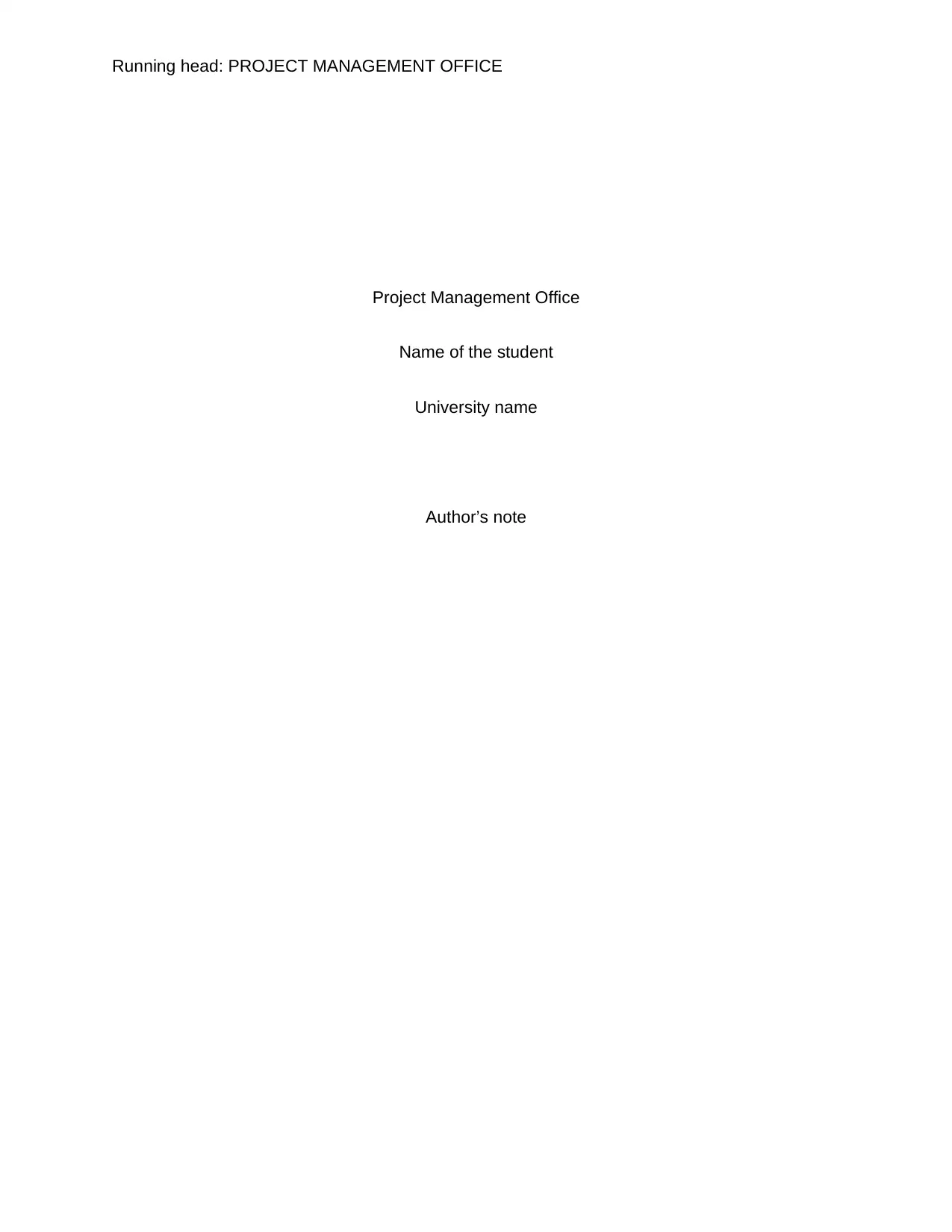
Running head: PROJECT MANAGEMENT OFFICE
Project Management Office
Name of the student
University name
Author’s note
Project Management Office
Name of the student
University name
Author’s note
Paraphrase This Document
Need a fresh take? Get an instant paraphrase of this document with our AI Paraphraser
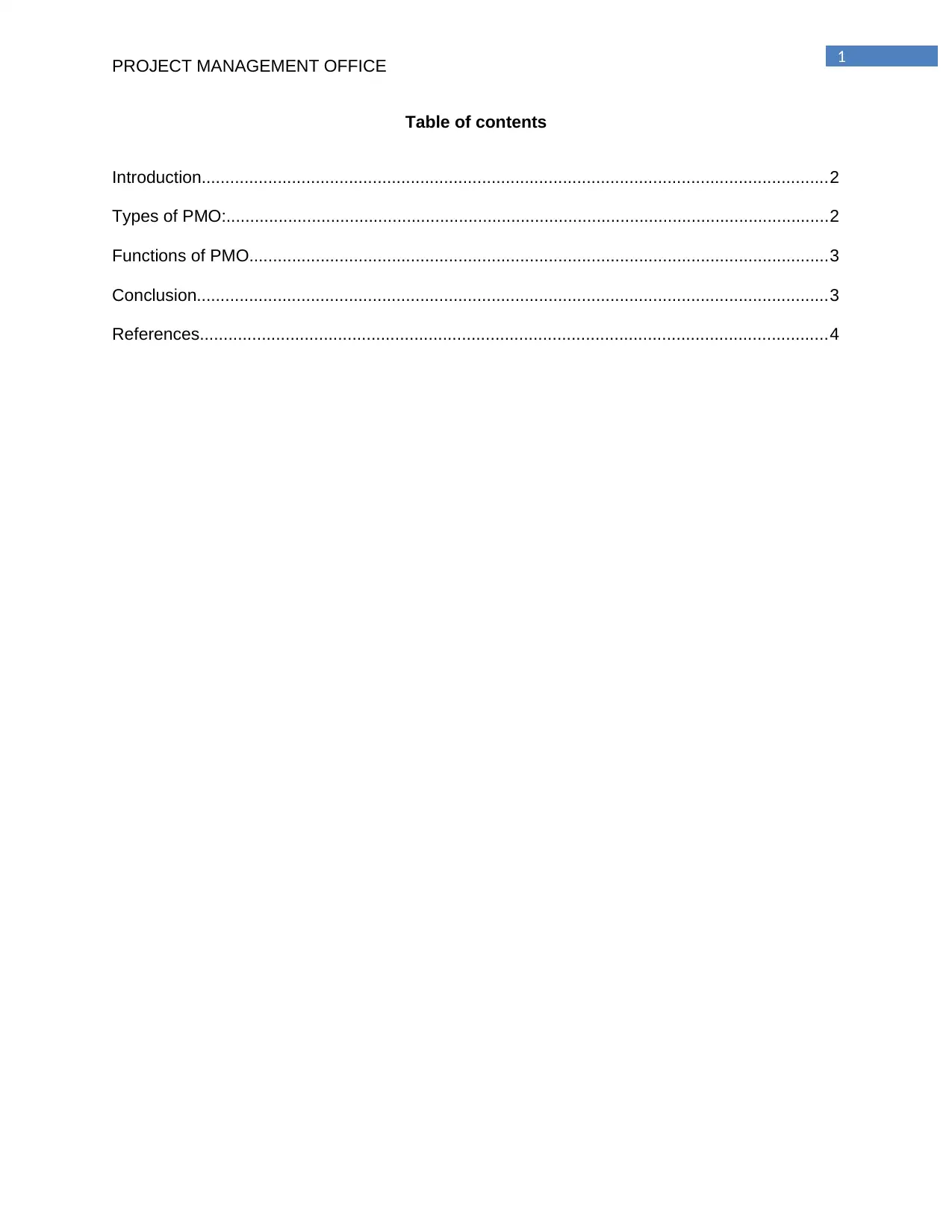
1
PROJECT MANAGEMENT OFFICE
Table of contents
Introduction....................................................................................................................................2
Types of PMO:...............................................................................................................................2
Functions of PMO..........................................................................................................................3
Conclusion.....................................................................................................................................3
References....................................................................................................................................4
PROJECT MANAGEMENT OFFICE
Table of contents
Introduction....................................................................................................................................2
Types of PMO:...............................................................................................................................2
Functions of PMO..........................................................................................................................3
Conclusion.....................................................................................................................................3
References....................................................................................................................................4
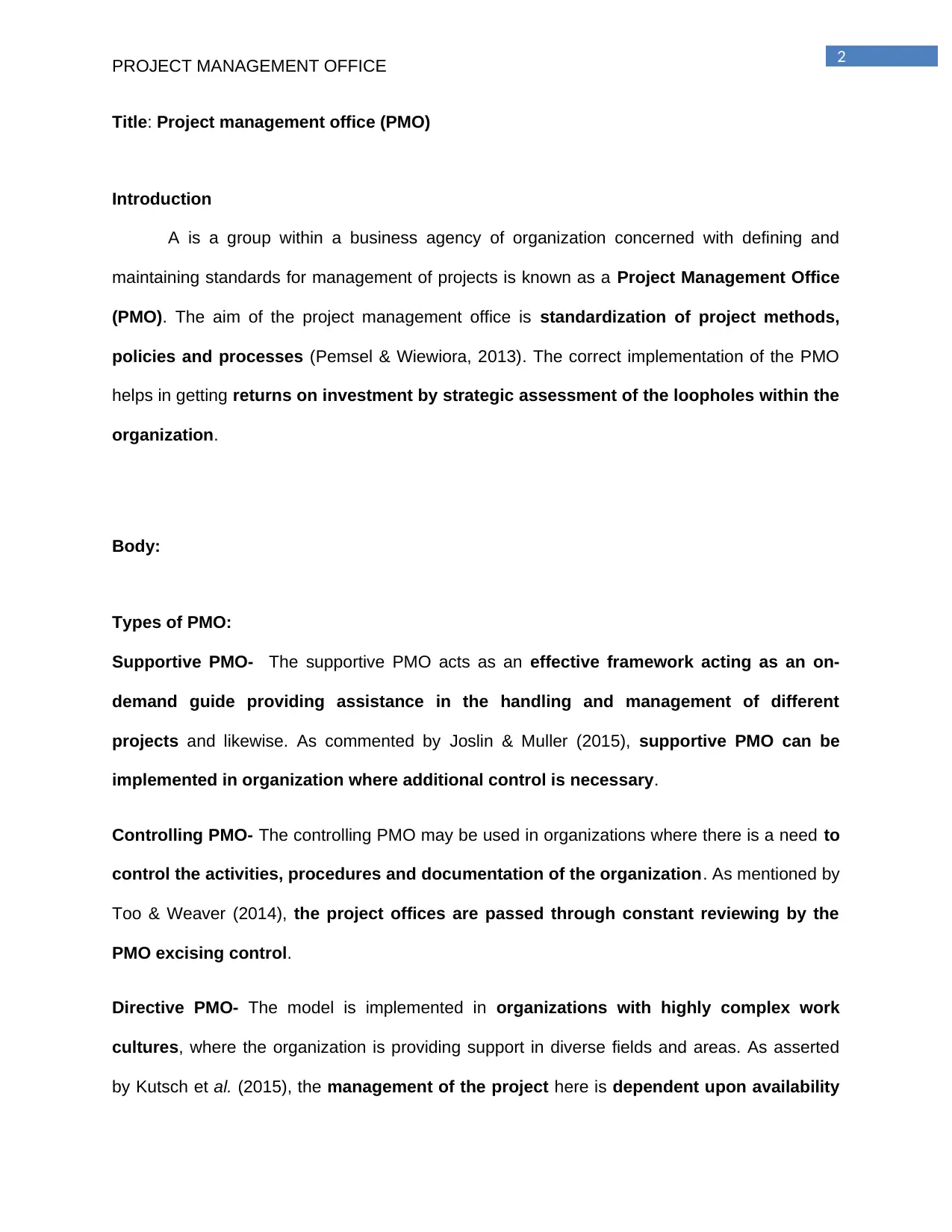
2
PROJECT MANAGEMENT OFFICE
Title: Project management office (PMO)
Introduction
A is a group within a business agency of organization concerned with defining and
maintaining standards for management of projects is known as a Project Management Office
(PMO). The aim of the project management office is standardization of project methods,
policies and processes (Pemsel & Wiewiora, 2013). The correct implementation of the PMO
helps in getting returns on investment by strategic assessment of the loopholes within the
organization.
Body:
Types of PMO:
Supportive PMO- The supportive PMO acts as an effective framework acting as an on-
demand guide providing assistance in the handling and management of different
projects and likewise. As commented by Joslin & Muller (2015), supportive PMO can be
implemented in organization where additional control is necessary.
Controlling PMO- The controlling PMO may be used in organizations where there is a need to
control the activities, procedures and documentation of the organization. As mentioned by
Too & Weaver (2014), the project offices are passed through constant reviewing by the
PMO excising control.
Directive PMO- The model is implemented in organizations with highly complex work
cultures, where the organization is providing support in diverse fields and areas. As asserted
by Kutsch et al. (2015), the management of the project here is dependent upon availability
PROJECT MANAGEMENT OFFICE
Title: Project management office (PMO)
Introduction
A is a group within a business agency of organization concerned with defining and
maintaining standards for management of projects is known as a Project Management Office
(PMO). The aim of the project management office is standardization of project methods,
policies and processes (Pemsel & Wiewiora, 2013). The correct implementation of the PMO
helps in getting returns on investment by strategic assessment of the loopholes within the
organization.
Body:
Types of PMO:
Supportive PMO- The supportive PMO acts as an effective framework acting as an on-
demand guide providing assistance in the handling and management of different
projects and likewise. As commented by Joslin & Muller (2015), supportive PMO can be
implemented in organization where additional control is necessary.
Controlling PMO- The controlling PMO may be used in organizations where there is a need to
control the activities, procedures and documentation of the organization. As mentioned by
Too & Weaver (2014), the project offices are passed through constant reviewing by the
PMO excising control.
Directive PMO- The model is implemented in organizations with highly complex work
cultures, where the organization is providing support in diverse fields and areas. As asserted
by Kutsch et al. (2015), the management of the project here is dependent upon availability
⊘ This is a preview!⊘
Do you want full access?
Subscribe today to unlock all pages.

Trusted by 1+ million students worldwide
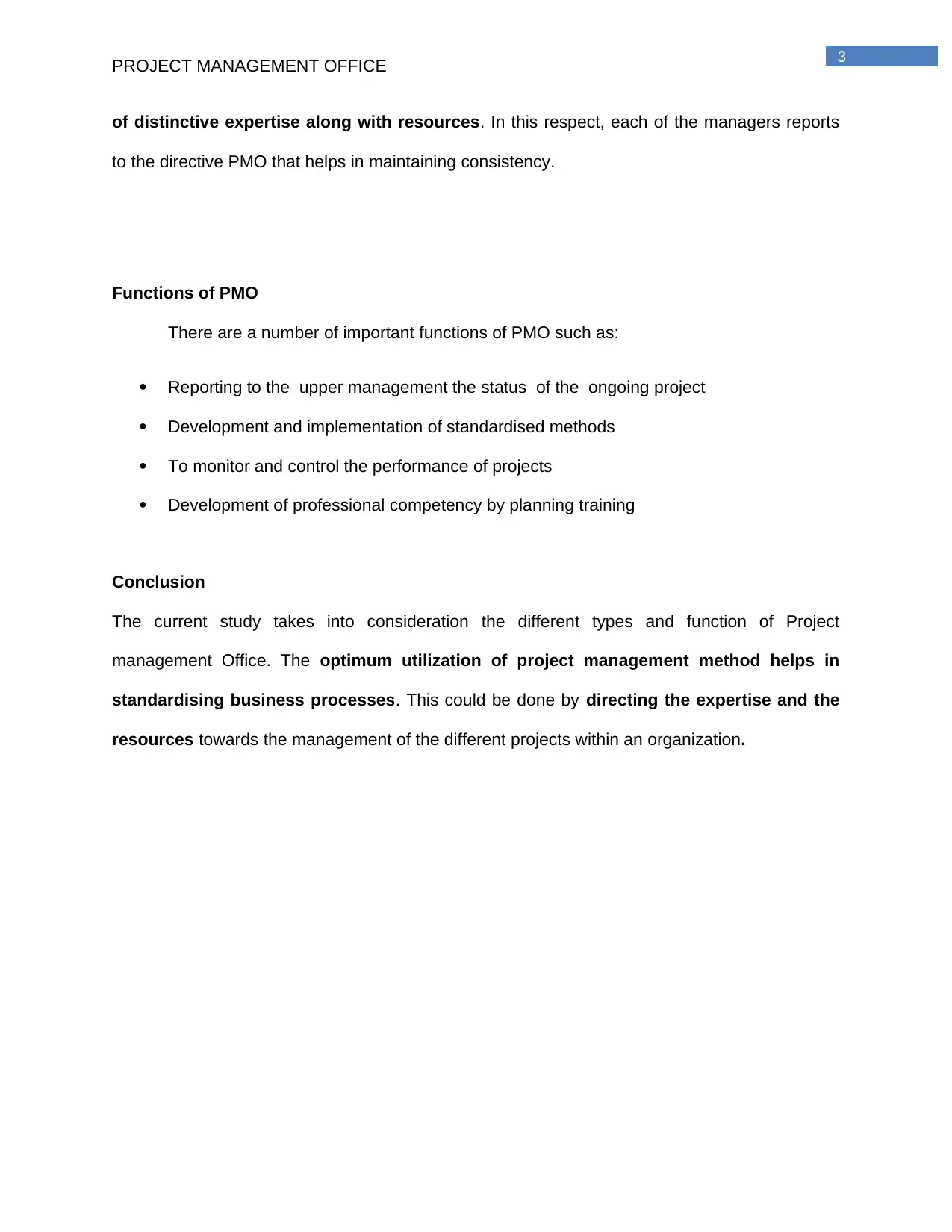
3
PROJECT MANAGEMENT OFFICE
of distinctive expertise along with resources. In this respect, each of the managers reports
to the directive PMO that helps in maintaining consistency.
Functions of PMO
There are a number of important functions of PMO such as:
Reporting to the upper management the status of the ongoing project
Development and implementation of standardised methods
To monitor and control the performance of projects
Development of professional competency by planning training
Conclusion
The current study takes into consideration the different types and function of Project
management Office. The optimum utilization of project management method helps in
standardising business processes. This could be done by directing the expertise and the
resources towards the management of the different projects within an organization.
PROJECT MANAGEMENT OFFICE
of distinctive expertise along with resources. In this respect, each of the managers reports
to the directive PMO that helps in maintaining consistency.
Functions of PMO
There are a number of important functions of PMO such as:
Reporting to the upper management the status of the ongoing project
Development and implementation of standardised methods
To monitor and control the performance of projects
Development of professional competency by planning training
Conclusion
The current study takes into consideration the different types and function of Project
management Office. The optimum utilization of project management method helps in
standardising business processes. This could be done by directing the expertise and the
resources towards the management of the different projects within an organization.
Paraphrase This Document
Need a fresh take? Get an instant paraphrase of this document with our AI Paraphraser
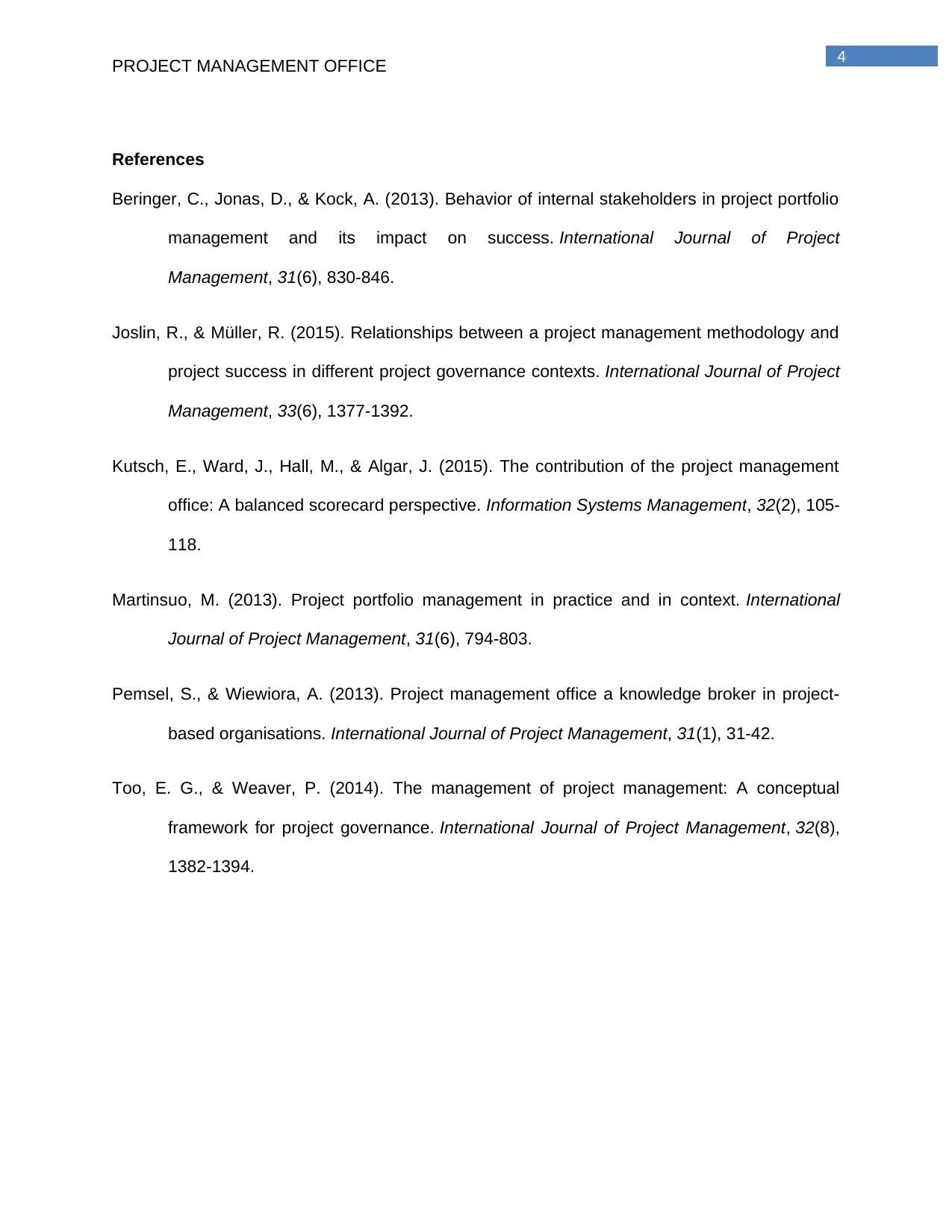
4
PROJECT MANAGEMENT OFFICE
References
Beringer, C., Jonas, D., & Kock, A. (2013). Behavior of internal stakeholders in project portfolio
management and its impact on success. International Journal of Project
Management, 31(6), 830-846.
Joslin, R., & Müller, R. (2015). Relationships between a project management methodology and
project success in different project governance contexts. International Journal of Project
Management, 33(6), 1377-1392.
Kutsch, E., Ward, J., Hall, M., & Algar, J. (2015). The contribution of the project management
office: A balanced scorecard perspective. Information Systems Management, 32(2), 105-
118.
Martinsuo, M. (2013). Project portfolio management in practice and in context. International
Journal of Project Management, 31(6), 794-803.
Pemsel, S., & Wiewiora, A. (2013). Project management office a knowledge broker in project-
based organisations. International Journal of Project Management, 31(1), 31-42.
Too, E. G., & Weaver, P. (2014). The management of project management: A conceptual
framework for project governance. International Journal of Project Management, 32(8),
1382-1394.
PROJECT MANAGEMENT OFFICE
References
Beringer, C., Jonas, D., & Kock, A. (2013). Behavior of internal stakeholders in project portfolio
management and its impact on success. International Journal of Project
Management, 31(6), 830-846.
Joslin, R., & Müller, R. (2015). Relationships between a project management methodology and
project success in different project governance contexts. International Journal of Project
Management, 33(6), 1377-1392.
Kutsch, E., Ward, J., Hall, M., & Algar, J. (2015). The contribution of the project management
office: A balanced scorecard perspective. Information Systems Management, 32(2), 105-
118.
Martinsuo, M. (2013). Project portfolio management in practice and in context. International
Journal of Project Management, 31(6), 794-803.
Pemsel, S., & Wiewiora, A. (2013). Project management office a knowledge broker in project-
based organisations. International Journal of Project Management, 31(1), 31-42.
Too, E. G., & Weaver, P. (2014). The management of project management: A conceptual
framework for project governance. International Journal of Project Management, 32(8),
1382-1394.
1 out of 5
Related Documents
Your All-in-One AI-Powered Toolkit for Academic Success.
+13062052269
info@desklib.com
Available 24*7 on WhatsApp / Email
![[object Object]](/_next/static/media/star-bottom.7253800d.svg)
Unlock your academic potential
Copyright © 2020–2025 A2Z Services. All Rights Reserved. Developed and managed by ZUCOL.



